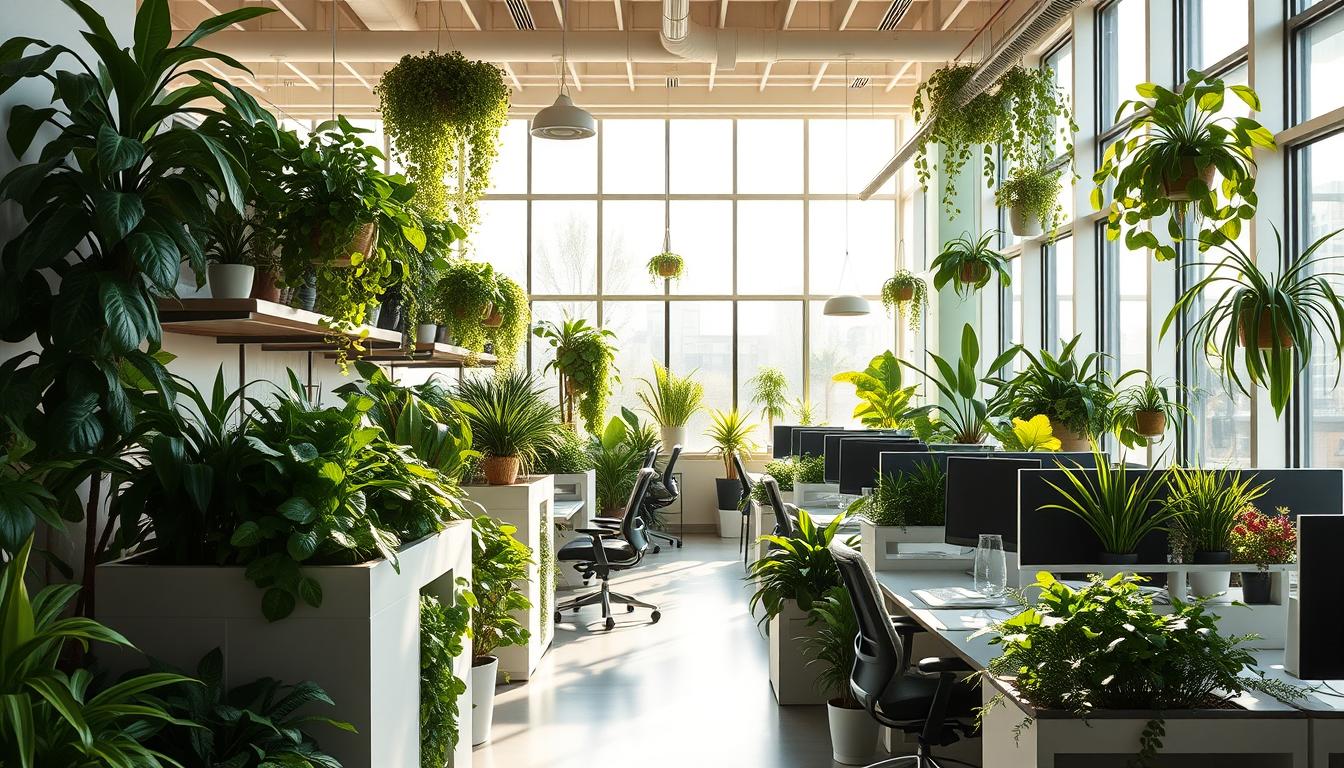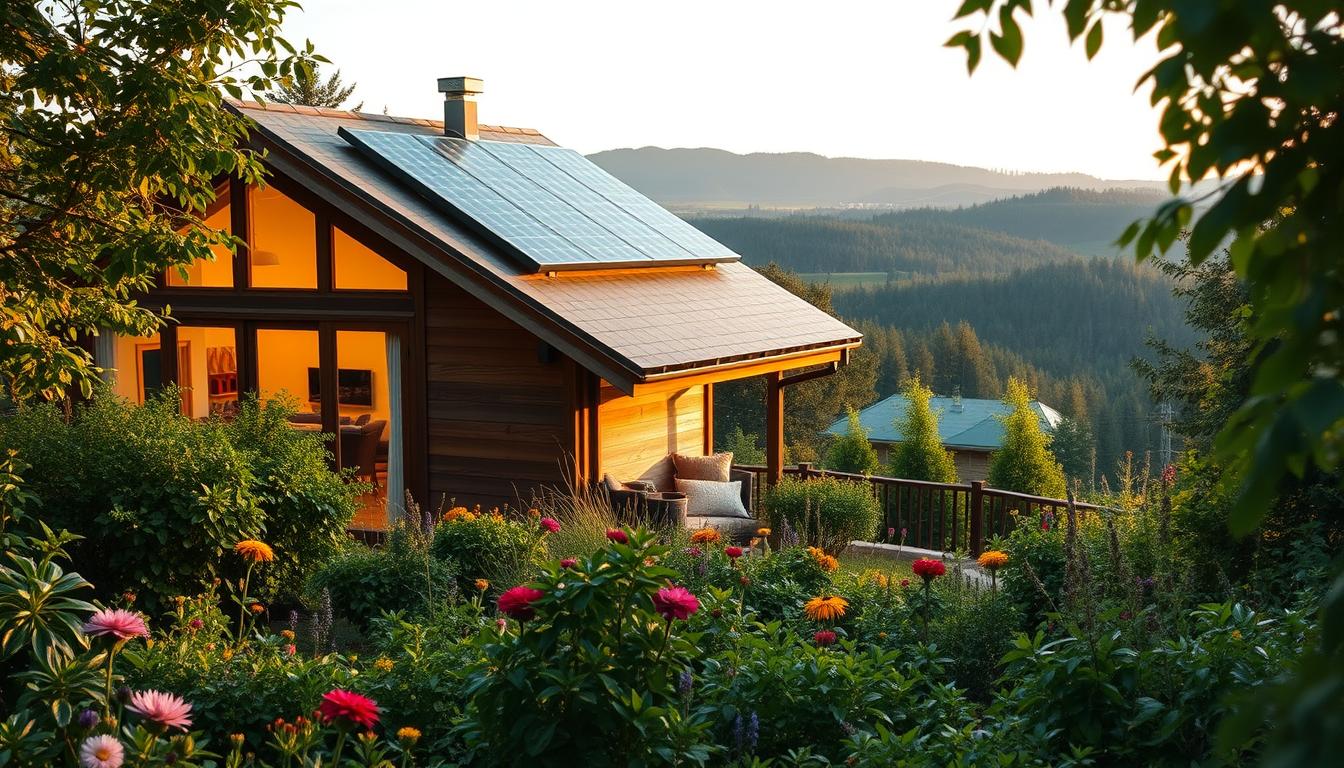The modern workplace is changing. Now, there’s more focus on mental well-being through design. Offices filled with nature are gaining popularity. They are seen as key to better employee health.
By adding biophilic design elements, these environments become healthier. They also help workers concentrate and be more productive. This article looks at how natural features in offices help. They make the work experience more calming, reduce stress, and boost job performance.
Understanding Cognitive Restoration
Cognitive restoration is key in improving employees’ work life and mental health. It means easing mental tiredness by connecting with nature. With fewer green areas in modern offices, it’s crucial for companies to grasp this idea. They aim to reduce stress and increase mental energy.
Definition of Cognitive Restoration
Cognitive restoration helps refresh our minds through nature. Studies show that being near natural elements boosts our well-being. Adding these elements to offices can lessen mental fatigue.
Importance in Modern Workspaces
Nowadays, many workers deal with extreme mental tiredness. It’s vital to understand cognitive restoration’s role in mental health at work. Modern offices often chase productivity, forgetting about employee comfort. Creating spaces for mental rest can improve focus, creativity, and happiness at work. Companies that support these ideas might see better team morale and work output.

Effects of Nature on Mental Health
The link between nature and our minds is getting a lot of attention. Studies show nature’s big impact, especially in reducing stress and making workers feel better. Being around nature helps our minds in many ways, important for dealing with today’s work stress.
Impact on Stress Reduction
Nature is key in helping people feel less stressed at work. Research has found that even a little time with nature can cut stress a lot. Theories like Attention Restoration Theory and Stress Recovery Theory explain why nature helps us relax and think better.
Being close to nature makes us feel calm, lowering anxiety. This makes for a much healthier work environment.
Connection Between Nature and Employee Well-Being
Adding natural elements at work is vital for employee happiness. Nature’s impact can make workers more motivated, leading to better work performance. Studies have found that workers around nature are more satisfied and creative.
Bringing nature into work doesn’t just help with mental health. It also makes the work culture better.
Cognitive Restoration in Nature-Infused Offices
Today’s workplaces are fast-paced. Adding nature into office design can greatly help with mental recovery. The presence of nature in workspaces makes them more welcoming. It encourages relaxation and helps the mind recharge. This marriage of nature with office design boosts well-being, productivity, and job satisfaction.
How Nature-Infused Designs Promote Cognitive Recovery
Nature-infused designs are key for cognitive recovery. They include:
- Indoor plants that better air quality and bring calm
- Water features that offer soothing sounds
- Natural light that lifts mood and energy
These elements help staff connect with their surroundings. They offer chances to pause and think. This is crucial for mental freshness and renewal.
Key Elements of a Nature-Infused Office
To make a workspace both productive and healing, consider these biophilic design elements:
- Views of nature through big windows or green walls
- Layouts that make moving and interacting easy
- Sounds of nature, like birds or water, to fill the space
These design ideas create a setting that not only aids in mental recovery. They also make the workplace feel better overall.
Principles of Biophilic Design
Biophilic design combines nature with modern architecture. It helps strengthen the bond between humans and nature inside buildings. By bringing natural elements to workplaces, it creates better spaces for health and work. These design rules greatly support employee mental well-being.
Definition of Biophilic Design
This design approach brings nature closer by using plants, sunlight, and natural textures. It’s based on our natural love for the outdoors, known as biophilia. This makes buildings feel more welcoming while connecting them with the environment.
Psychological Benefits of Integrating Nature
Adding nature to offices does more than just look good. The key benefits are:
- Improved mood and less stress.
- Better thinking skills and creativity.
- More focus and work output from employees.
Biophilic design makes workplaces nature-friendly, leading to a peaceful vibe that boosts mental health. Workers in such spaces often feel happier and more content with their jobs.
Benefits of Nature-Infused Workspaces
Nature-infused workspaces offer great benefits to employees’ health and work. They help in increasing focus and making people more productive. Adding natural elements like plants to offices also helps fight mental tiredness. This, in turn, makes for a healthier team at work.
Enhanced Focus and Productivity
Bringing nature into work spaces helps employees stay focused. Seeing natural beauty and having plants around create a setting that helps with concentrating. Studies show that being in such environments boosts creativity and solving problems.
- Increased job satisfaction
- Improved attention spans
- Higher overall output
This shows that nature in workspaces positively affects a company’s success.
Reduction of Work-Related Stress
Adding nature to work environments helps in reducing stress. Workers feel less anxious and more cheerful when their space has plants and natural light. These features help calm the mind, easing stress and tiredness. Think about how nature in the office can:
- Promote a sense of calm and relaxation
- Boost emotional strength
- Encourage working together and building connections
These stress-lowering aspects help improve both personal well-being and team work culture.
Types of Biophilic Design Elements
Adding biophilic design elements to office spaces can greatly improve employee happiness and work output. These features help feel closer to nature, which makes a place better for thinking clearly. Here are the main types of biophilic design elements that can make offices better.
Natural Lighting and Ventilation
Natural lighting is a key part of biophilic design. It not only makes people happier but also more energetic. By using big windows and skylights, sunlight fills the office, cutting down on artificial light. Good airflow also makes the work area healthier by cleaning the air, helping employees to feel more awake and sharp.
Plant Integration and Indoor Gardens
Adding plants and making indoor gardens are critical for biophilic design. They make the air cleaner. Plants take in bad stuff and give out oxygen. Having plants around lowers stress, and studies have found workers are more productive with greenery around them. Indoor gardens offer a peaceful spot for breaks, helping with mental wellness and clear thinking.
Water Features and Their Effects
Water features aren’t just nice to look at but also bring calm. Putting in fountains or water walls adds sounds that lower stress. The noise of water moving helps make a peaceful office setting, aiding in focus and calmness. These features add to the visual and sound experience in a workspace connected with nature.
Designing Nature-Infused Office Spaces
Today’s workplaces need spaces that help minds relax and restore. It’s crucial to mix in features that help relax and bring wellness. Break areas are key for this goal. They offer a space away from work where employees can refresh. Natural elements like plants and water features make these places peaceful and welcoming.
Creating Restorative Break Areas
To connect employees with nature, consider these for break areas:
- Preserved gardens with native plants
- Moss walls that reduce noise and improve air quality
- Water features for soothing soundscapes
These additions are not just pretty. They bring peace, urging staff to step away and relax during the day.
Incorporating Natural Materials
Using natural materials can make the office feel warm and inviting. Think about including wood, stone, and plants all around. Great ideas are:
- Using reclaimed wood for furniture and decorative elements
- Implementing stone accents in walls or flooring
- Choosing sustainable textiles for seating and upholstery
These choices show care for employee health and balance. Mixing these elements creates a supportive and energetic office vibe.
Case Studies on Nature-Infused Offices
Many case studies show how adding nature to offices changes them for the better. They prove nature helps make employees happier, more productive, and healthier. This shows how important it is to include natural elements in office designs.
Successful Implementations in Corporations
Some big companies have put this idea to work. They’ve seen great results. Here are some examples:
- Google’s campus is full of plants and natural light. This makes for a creative and team-friendly place.
- Microsoft’s offices have indoor gardens. This helps employees feel calm and happy.
- Amazon Go stores use natural wood and stone for a warm, welcoming feel for everyone there.
Measurable Outcomes of Biophilic Design
The benefits of these nature-focused office designs can be clearly seen:
- Employees are less stressed. This means they’re more involved and happy at work.
- There’s less absence due to sickness. This shows employees are healthier and feeling better about their job.
- Creativity and innovation are up. This is key for a company’s success and growth.
Challenges in Designing Nature-Infused Offices
Bringing nature into office designs has its hurdles. Companies aim to make offices healthier. They must understand what might get in the way. Important factors must be considered to blend nature with office spaces effectively.
Cost Considerations
Nature designs in offices can be costly. Adding things like indoor gardens and natural materials can require a big budget. Companies often struggle to afford these changes without sacrificing other needs. High-end materials and features come with big price tags, making office design tough.
Space Limitations and Land Availability
In cities, it’s hard to add nature to offices because space is tight. Many buildings can’t fit natural elements easily. Also, there’s little room in cities for outdoor areas that add to the natural feel. Finding creative ways to use small spaces is key.
Future Trends in Office Design
The way we design offices is changing to focus more on how people feel. Businesses understand that happy, healthy workplaces make for happier, healthier workers. So, they’re working to create offices that are not just about work, but also about feeling good.
Bringing nature inside, through things like biophilic design, is a big part of this change. It’s all about making work spaces where productivity and comfort go hand in hand.
Growing Importance of Employee Well-Being
Nowadays, companies are really caring about their employees’ well-being. They see it’s not just nice to have, but essential. Happy employees work better and stick around longer.
So, making offices that help rather than hurt our mental health is becoming the norm. It’s about making everyone’s day-to-day better.
Innovations in Biophilic Design
Biophilic design is at the forefront of the next wave of office spaces. The idea is simple: bring more of the outside world in.
This could mean more sunlight, more plants, and even water features. Not only does it look good, but it makes us feel good too. It’s about creating a peaceful balance between work and nature.
Conclusion
Reflecting on how cognitive restoration affects workplace wellness shows that nature-filled offices improve well-being. These spaces help workers focus better and feel mentally healthier. This shows that companies caring for these designs value their employees greatly.
Companies that include nature in the office make workers happier and more likely to stay. Adding plants, daylight, and open spaces helps minds rest and creativity blossom. It also cuts down on stress. As more businesses see the value in happy, healthy workplaces, knowing about cognitive restoration gets even more important.
Creating a work culture that is balanced starts with understanding design’s impact on mental health. Making nature a big part of office design is a key move toward a more productive and happier workplace future. This shows that choosing a nature-infused workspace is smart for the company’s culture.



